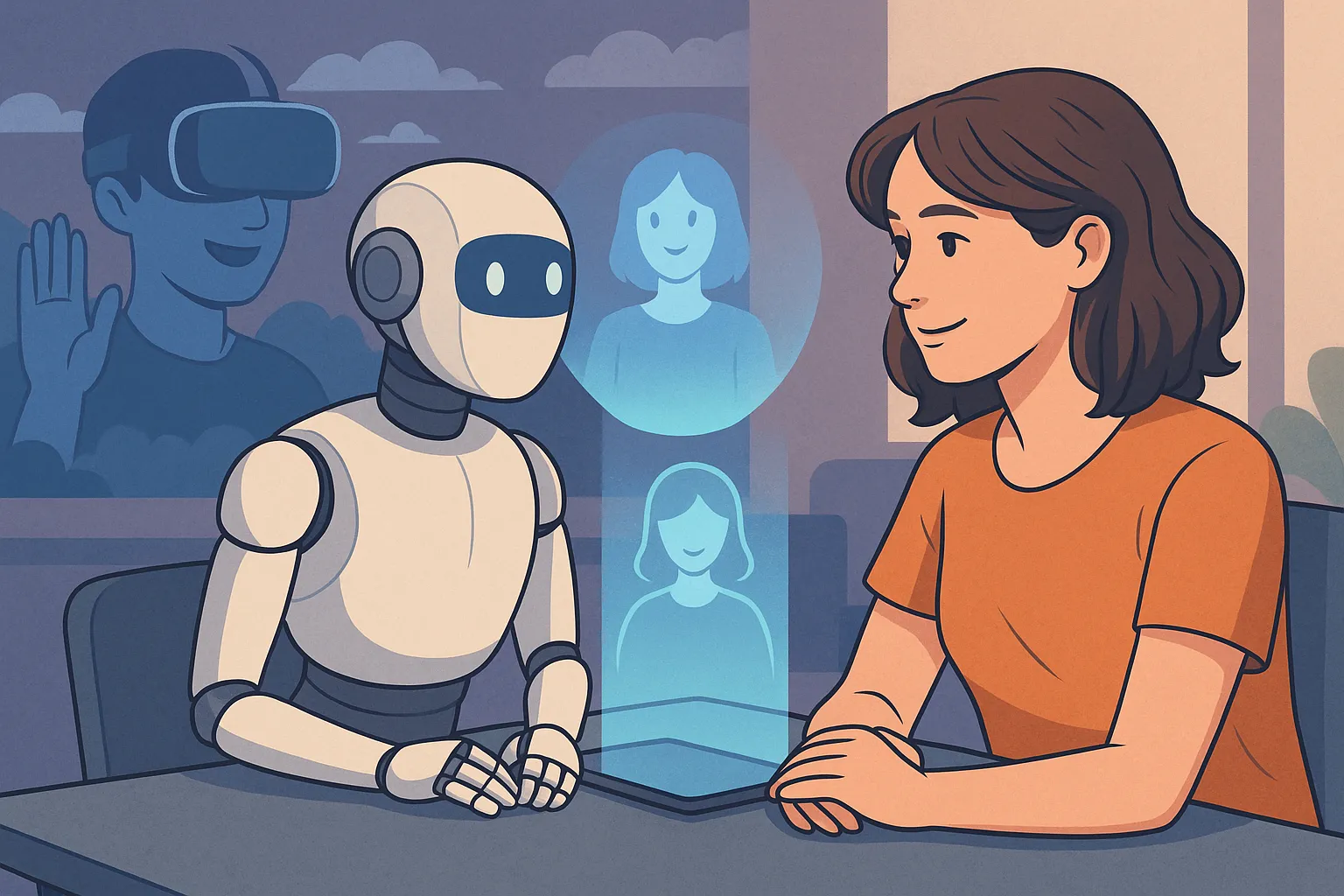The Double-Edged Nature of Technology in Human Connection
For centuries, relationships were bound by geography, community, and circumstance. Technology, however, has radically transformed these boundaries, reshaping how humans connect with one another. On one side, it has introduced unprecedented opportunities for intimacy, allowing people to share their lives instantly across great distances. On the other, it has deepened feelings of isolation, as digital interactions sometimes replace the richness of physical presence. The story of modern relationships is one of both promise and paradox, where the same tools that connect us can also keep us apart.
From text messages to video calls, from social networks to virtual reality, technology has woven itself into the fabric of human intimacy. To understand how it is changing relationships, it is important to explore both the challenges it creates and the new forms of closeness it makes possible.
The Rise of Digital Communication
The past few decades have seen a shift from face-to-face communication to digital channels. Email, text messaging, and instant messaging replaced letters and phone calls, while social media introduced entirely new ways of staying in touch. Today, entire friendships and romantic relationships can unfold primarily online, sustained by constant digital interaction.
This shift has expanded the scope of human connection. Long-distance relationships that once seemed impossible now thrive through video calls and instant messaging. Friendships can be maintained across continents with daily updates on social media. The accessibility of digital communication means that people can remain present in each other’s lives in ways unimaginable a generation ago.
Yet this constant connectivity can also dilute interactions. Quick text exchanges may replace deeper conversations, and carefully curated online personas can make relationships feel less authentic. The abundance of contact does not always translate into emotional closeness, highlighting the paradox of digital intimacy.
Social Media and the Illusion of Connection
Social media has become a cornerstone of modern relationships. Platforms like Facebook, Instagram, and TikTok allow people to share life updates, celebrate milestones, and express support. At its best, social media fosters community, helping individuals feel seen and connected. It can strengthen bonds by providing daily glimpses into each other’s lives, even when physical interaction is rare.
However, social media also creates the illusion of intimacy. A “like” or a comment may substitute for meaningful conversation, and curated feeds often present idealized versions of life rather than authentic experiences. This can lead to comparison, insecurity, and feelings of inadequacy. Relationships may appear strong online while lacking depth offline.
The key challenge lies in balancing digital expressions of support with genuine engagement. Without intentional effort, social media risks becoming a superficial substitute for true intimacy.
Technology’s Role in Overcoming Isolation
Despite these risks, technology plays a vital role in reducing isolation, especially for vulnerable groups. For elderly individuals, video calls with family members provide comfort and a sense of inclusion. For those with disabilities, online communities offer spaces for connection and support. For people facing mental health challenges, digital platforms provide access to counseling and peer groups that might otherwise be inaccessible.
During the COVID-19 pandemic, technology demonstrated its capacity to maintain relationships under extreme circumstances. Virtual gatherings, online events, and video conferencing became lifelines, keeping families, friends, and colleagues connected. In moments of physical isolation, digital tools proved that they could sustain intimacy, even if imperfectly.
This highlights an essential truth: technology is not inherently isolating or connecting. Its impact depends on how it is used. When leveraged thoughtfully, it can bridge distances and create spaces for belonging.
The Transformation of Romantic Relationships
Romantic relationships have been particularly transformed by technology. Online dating platforms have revolutionized how people meet, making it possible to find partners outside traditional social circles. Algorithms match individuals based on interests, values, and compatibility, expanding the possibilities for connection.
These platforms have also normalized the idea of relationships beginning online. What once carried stigma is now mainstream, with countless couples meeting through apps and websites. For many, digital platforms are not just convenient but essential in a world where traditional avenues of meeting are limited.
Yet online dating also introduces new challenges. The abundance of choice can create a “shopping” mentality, where individuals are evaluated as profiles rather than people. Superficial judgments based on photos or short bios can overshadow deeper qualities. At the same time, the rise of ghosting and other digital behaviors has introduced new forms of emotional strain.
Nevertheless, the success of many online relationships demonstrates the power of technology to foster genuine intimacy. For couples separated by geography, digital tools provide the foundation for maintaining closeness until physical proximity becomes possible.
The Emergence of Digital Companionship
Beyond human-to-human relationships, technology has given rise to new forms of companionship. AI-driven chatbots, virtual assistants, and even robotic companions are increasingly designed to simulate social interaction. For some, these digital entities provide comfort, entertainment, or support in moments of loneliness.
The idea of forming bonds with artificial companions may seem strange, yet it reflects a natural human tendency to anthropomorphize. People name their cars, talk to their pets, and assign personalities to inanimate objects. Digital companions extend this instinct into the realm of technology, offering a form of intimacy that is predictable, safe, and always available.
While these relationships cannot replace human connection, they illustrate how technology is expanding the very definition of companionship. As AI becomes more sophisticated, digital partners may play increasingly prominent roles in the social fabric of human life.
Technology and Family Bonds
Families, too, have been reshaped by technology. Video calls connect grandparents with grandchildren, group chats keep siblings in constant contact, and shared online spaces allow families to celebrate milestones even from afar. Technology makes it possible to maintain bonds across distances that once would have strained or severed relationships.
At the same time, technology can intrude on family life. Parents and children may be physically present but mentally absorbed in screens. Family dinners disrupted by phones or constant notifications highlight the tension between digital engagement and real-world presence. To preserve intimacy, families must intentionally set boundaries that allow for meaningful interaction.
The Blending of Physical and Digital Intimacy
Perhaps the most striking transformation is the blending of physical and digital intimacy. Virtual reality, augmented reality, and other immersive technologies are creating experiences that feel increasingly real. Couples can “meet” in virtual spaces, friends can explore digital worlds together, and families can gather in immersive environments. These technologies expand the possibilities of togetherness, offering ways to connect that transcend physical limitations.
The future may see even deeper integration, where physical and digital intimacy coexist seamlessly. The challenge will be ensuring that these new forms of connection enhance rather than replace the richness of in-person relationships.
The Risks of Overreliance on Digital Intimacy
As digital tools become increasingly central to human relationships, one of the greatest risks is overreliance. For many, online interactions or digital companions can feel safer and easier than navigating the unpredictability of human relationships. Messages can be edited before sending, avatars can be tailored to perfection, and digital companions never argue or disappoint.
This predictability, while comforting, can discourage people from engaging in the complexity of real-world intimacy. Over time, users may begin to prefer digital interactions to physical ones, leading to social withdrawal. The convenience of digital closeness may reduce the motivation to invest in deeper, sometimes more difficult, face-to-face connections.
Children and young adults are especially vulnerable. Growing up with devices and digital companionship, they may develop expectations of relationships that prioritize constant availability and emotional responsiveness. When human interactions inevitably fall short, disappointment and frustration may follow. This highlights the importance of fostering digital literacy and teaching balance between online and offline relationships.
Ethical Concerns of AI Companionship
AI-driven companionship presents profound ethical challenges. If machines are designed to mimic care, empathy, or affection, does that cross a line into deception? Some argue that it is acceptable if the outcomes are positive — if a lonely person feels comforted by an AI friend, then the relationship provides value. Others warn that normalizing simulated intimacy could weaken the importance of genuine empathy in human society.
Privacy is another ethical concern. AI companions, to be effective, often collect intimate data — including conversations, preferences, and emotional cues. If this data is misused or exploited, it could cause harm far beyond the intended relationship. For example, emotional data might be sold to marketers to influence consumer behavior, raising questions about consent and manipulation.
Clear ethical standards are needed. Transparency about the artificial nature of digital companions, limits on data collection, and protections against emotional exploitation will be essential. Without such safeguards, the risks of manipulation could outweigh the benefits of companionship.
Cultural Differences in the Digital Intimacy Landscape
How societies respond to digital intimacy varies greatly across cultures. In Japan and South Korea, where technology is often embraced as a natural extension of life, digital companions and robotic partners are viewed with less skepticism. Robots in nursing homes or AI-driven “friends” for young people are considered innovative solutions rather than threats.
In contrast, Western cultures often exhibit greater concern about authenticity and replacement of human relationships. Media portrayals of robots and AI frequently emphasize danger or loss of humanity, shaping public opinion with skepticism. As a result, digital companions may be adopted more slowly in these regions.
Cultural context also influences how technology is used. In collectivist societies, digital tools may strengthen community bonds, while in individualistic societies, they may reinforce personal autonomy and choice. These cultural differences will shape the future of digital intimacy, producing diverse approaches to balancing technology and human connection.
Technology’s Role in Long-Distance and Cross-Boundary Relationships
For couples, families, and friends separated by geography, technology has become a lifeline. Video calls, instant messaging, and shared digital spaces make it possible to maintain closeness across vast distances. Romantic relationships that once would have faded can now thrive online, with couples celebrating milestones virtually until they can reunite in person.
Cross-boundary relationships — such as international friendships or intercultural romances — also benefit. Digital tools enable people from different backgrounds to connect, learn from one another, and build bonds that transcend geography. In this sense, technology not only sustains intimacy but also expands the diversity of human connection.
The challenge is ensuring these digital relationships remain balanced. While virtual togetherness can sustain intimacy, it cannot fully replace physical closeness. The risk lies in believing that digital contact is sufficient when, in reality, shared experiences in the physical world remain irreplaceable.
The Blurring of Public and Private Lives
Another transformation brought by digital intimacy is the blurring of public and private spheres. Social media encourages people to share aspects of their personal lives publicly, from milestones to everyday routines. While this fosters a sense of connection, it also creates new pressures. Relationships may be performed for audiences rather than lived authentically.
Couples may feel the need to post about their happiness online, even during difficult times, while friendships may be evaluated by public interactions rather than private depth. This blending of intimacy and performance can distort the true nature of relationships, making them appear stronger or weaker than they actually are.
To preserve authenticity, individuals must learn to navigate what is shared publicly and what remains private. Digital intimacy should support real bonds, not reduce them to curated images.
Virtual Reality and the Future of Shared Presence
Virtual reality (VR) is pushing intimacy into new dimensions. Instead of simply communicating through screens, VR allows people to share immersive environments. Couples can watch movies together in a virtual theater, families can celebrate birthdays in digital spaces, and friends can explore fantastical landscapes side by side.
The sense of presence in VR — the feeling of truly “being there” with another person — creates new possibilities for intimacy. For long-distance relationships, this can be transformative, offering shared experiences that feel far more real than text or video.
Looking forward, as VR technology advances, the line between physical and digital togetherness will continue to blur. The challenge will be ensuring these virtual experiences enrich real relationships rather than replace them.
Redefining Loneliness in the Digital Age
Technology is not eliminating loneliness; it is redefining it. People today can be connected to hundreds of others online yet still feel isolated. This is because digital connection does not always translate into emotional closeness. The quantity of interactions is not a substitute for quality.
At the same time, digital companionship can provide meaningful relief for those who might otherwise be completely alone. For some, an AI companion or online community may be the only source of daily interaction. While imperfect, these relationships can offer stability, comfort, and even hope.
The challenge is to recognize the difference between connection and intimacy. True intimacy requires vulnerability, trust, and reciprocity — qualities that technology can simulate but not fully replicate. Balancing digital and human relationships will be critical to addressing loneliness in the years ahead.
Building Healthy Digital Relationships
To harness the benefits of technology while minimizing risks, individuals and societies must learn to build healthy digital relationships. This includes:
- Setting boundaries between online and offline time.
- Prioritizing depth in digital interactions over superficial engagement.
- Being transparent about the artificial nature of digital companions.
- Cultivating balance by using technology to supplement, not replace, real-world intimacy.
Education is also essential. Teaching digital literacy — including how to manage online presence, recognize manipulation, and maintain balance — will empower individuals to navigate technology responsibly.
Conclusion: From Isolation to Intimacy
The transformation of relationships through technology is complex, marked by both promise and peril. On one hand, digital tools bridge distances, expand possibilities for connection, and reduce isolation. On the other, they risk fostering dependency, blurring authenticity, and replacing depth with convenience.
The journey from isolation to intimacy in the digital age is not linear. It requires careful choices about how technology is designed, adopted, and used. If approached responsibly, technology can enrich human relationships, making them more resilient, inclusive, and adaptable. If not, it may deepen loneliness and weaken the bonds that define our humanity.
Ultimately, technology does not determine the future of relationships — people do. By balancing digital and physical intimacy, society can ensure that technology serves as a bridge, not a barrier, to genuine human connection.





